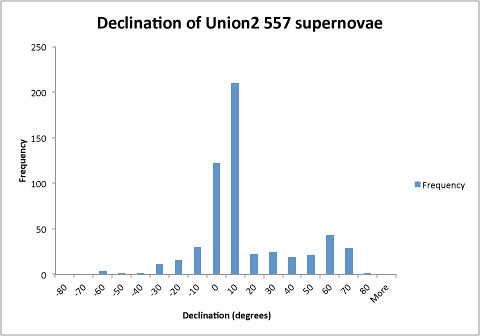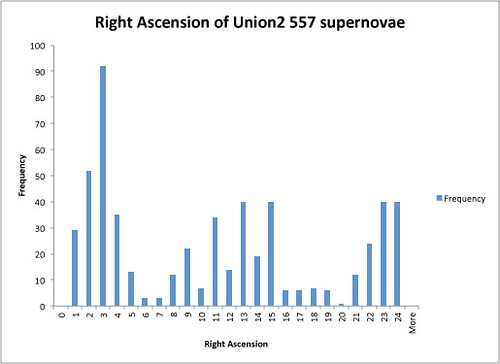CIP highlighted a paper just out,< in which the researchers look at how fast the universe is expanding in different directions, and find an asymmetry. How they examine this is by looking at the data from 557 type1A supernovae. These supernovae are well-calibrated "standard candles" which means that we know their intrinsic brightness. Their observed brightness, and their redshifts tell us how far away they are and how fast they are receding from us.
Well, they find an asymmetry. The link that CIP provided gives a better description than my two sentences above.
My purpose in writing this post, apart from drawing your attention to this, is to merely note that one can get to the Union2 compilation of the 557 supernovae (though better follow reference 15 in the arxiv paper that CIP links). Their positions in the sky are given by right ascension and declination. One would wish that the sample of supernovae used was reasonably uniformly distributed in the sky. I don't know what systematic errors in finding the asymmetry are caused by them not being so. Simple histograms produced in Microsoft Excel are shown below. A uniform distribution in the sky would produce a uniform distribution in right ascension (think of it as longitude) and a cosine (zero at +/-90 and maximum at 0, think of it as latitude and think of the diminishing area of a sphere in successive bands of latitude).


My purpose in writing this post, apart from drawing your attention to this, is to merely note that one can get to the Union2 compilation of the 557 supernovae (though better follow reference 15 in the arxiv paper that CIP links). Their positions in the sky are given by right ascension and declination. One would wish that the sample of supernovae used was reasonably uniformly distributed in the sky. I don't know what systematic errors in finding the asymmetry are caused by them not being so. Simple histograms produced in Microsoft Excel are shown below. A uniform distribution in the sky would produce a uniform distribution in right ascension (think of it as longitude) and a cosine (zero at +/-90 and maximum at 0, think of it as latitude and think of the diminishing area of a sphere in successive bands of latitude).


PS: Using http://ned.ipac.caltech.edu/forms/calculator.html
I think the direction of the axis of symmetry (314,28)(galactic coordinates) from the paper is equivalently
Right Ascension: 13:38:33
Declination: -33:51:26
which you can locate on the graphs above.